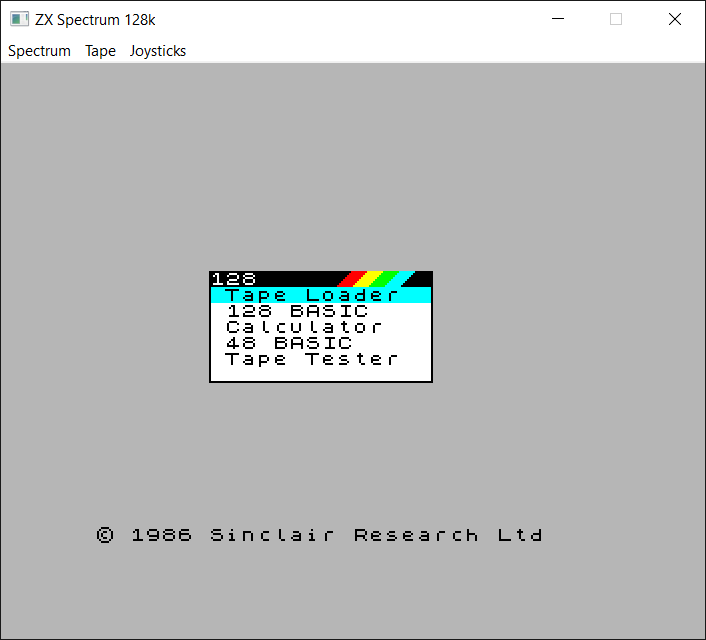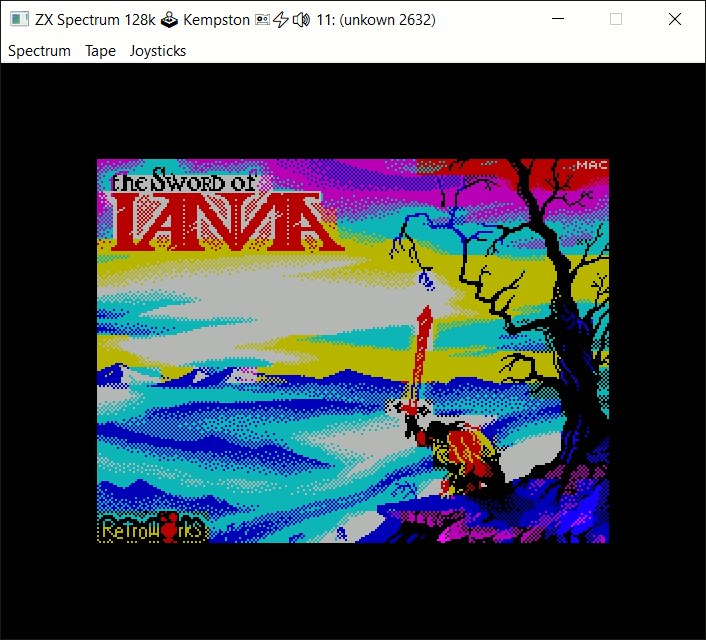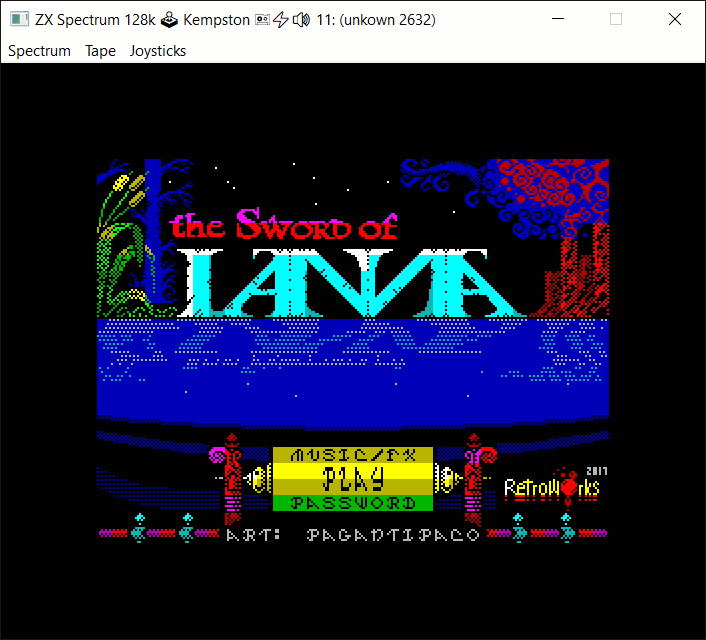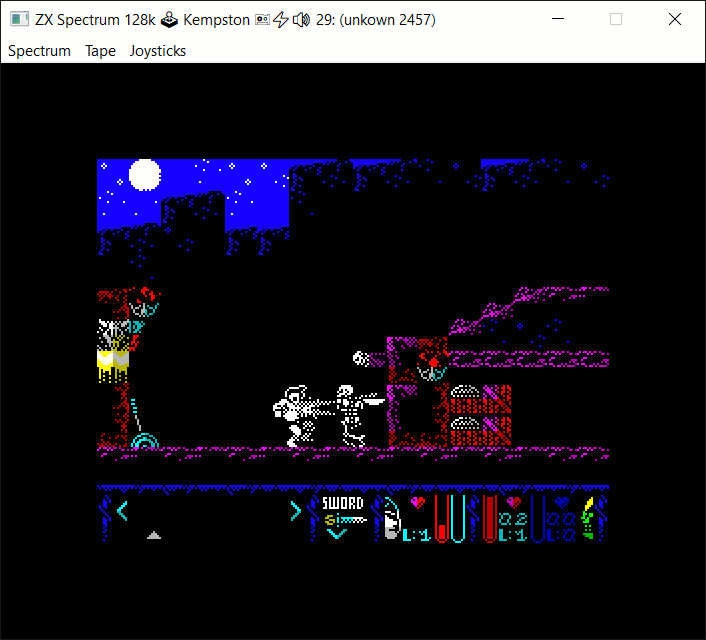Tutorial
How to build your own emulator with the SPECTRUSTY library.
This project is maintained by royaltm
SPECTRUSTY Tutorial
This is a part of the tutorial for the SPECTRUSTY library.
In this step, you can learn how to add different ZX Spectrum models with more peripherals.

Step 5 - 128
128 means 128kb RAM. It also means:
- 32kB ROM with 128k software,
- ULA128 with MMU and shadow screen memory,
- an AY-3-8910 Programmable Sound Processor
- .. with an RS-232 and an external keypad.
I’m going to skip the RS-232 in this tutorial. But otherwise, we’ll add a 128k model to the emulator that features all of the above.
First, update imports:
use spectrusty::audio::{
AudioSample, EarMicAmps4, EarOutAmps4, EarInAmps2,
Blep, BlepStereo, FromSample, UlaAudioFrame,
synth::BandLimited,
carousel::AudioFrameResult,
host::cpal::AudioHandleAnyFormat
};
use spectrusty::bus::{
BusDevice, NullDevice,
joystick::{
MultiJoystickBusDevice, JoystickSelect,
JoystickInterface
}
};
use spectrusty::clock::FTs;
use spectrusty::chip::{
ControlUnit, HostConfig, MemoryAccess,
UlaCommon, Ula128MemFlags, UlaControl,
ThreadSyncTimer,
ula::UlaPAL,
ula128::Ula128
};
use spectrusty::peripherals::{
ZXKeyboardMap,
serial::{SerialKeypad, KeypadKeys},
ay::audio::AyAmps
};
use spectrusty_utils::{
tap::{Tape, Tap},
keyboard::$implementation::{
update_keymap, update_keypad_keys,
update_joystick_from_key_event
}
};
Where $implementation is one of the available keyboard implementations for event loops.
Next, let’s refactor the ZxSpectrum struct by replacing UlaPAL with a generic U parameter:
#[derive(Default)]
struct ZxSpectrum<C: Cpu, U> {
cpu: C,
ula: U,
nmi_request: bool,
reset_request: Option<bool>,
state: EmulatorState
}
The reset_request property works similarly to nmi_request.
Ula128 provides a chipset implementation for ZX Spectrum 128k models. But we also need an emulator of AY-3-8910 PSG connected to the keypad via its IOA port. As you already know, we can “plug” it in as a static bus device. Let’s create a new type Ula128AyKeypad<D>, for convenience. It will be used as our 128k chipset type:
// a specialized AY-3-8910 bus device with a keypad
use spectrusty::bus::ay::serial128::Ay3_8912Keypad;
// define Ula128 with a static mandatory device
type Ula128AyKeypad<D=TerminatorDevice> = Ula128<Ay3_8912Keypad<D>>;
The exposed D parameter can be substituted by a device connected to the PSG as its NextDevice.
By default, D is our TerminatorDevice.
Now, let’s again define generic models:
type ZxSpectrum16k<C, D> = ZxSpectrum<C, UlaPAL<Memory16k, D>>;
type ZxSpectrum48k<C, D> = ZxSpectrum<C, UlaPAL<Memory48k, D>>;
type ZxSpectrum128k<C, D> = ZxSpectrum<C, Ula128AyKeypad<D>>;
Now, let’s look again at our pluggable-multi-joystick device:
// a pluggable joystick with run-time selectable joystick types
type PluggableMultiJoyBusDevice = OptionalBusDevice<
MultiJoystickBusDevice<
TerminatorDevice>>;
The last device in the chain determines the type of the timestamp used by the whole device chain.
So, let’s look at our TerminatorDevice from the previous chapter:
type TerminatorDevice = NullDevice<VFrameTs<UlaVideoFrame>>;
Aha! It appears that our device chain is using VFrameTs<UlaVideoFrame> as its BusDevice::Timestamp.
This can be a problem with our new 128k model, because Ula128 uses different VideoFrame: Ula128VidFrame.
How do we solve this? Can’t we just use another one that can work with all of our models?
Let’s take a look at the ControlUnit implementation of Ula. It appears that we can use a different type for the timestamp. As long as it satisfies the condition: From<VFrameTs<V: VideoFrame>>.
As always, you can define your own timestamp type, but we already have one that fulfills such a requirement: FTs.
type TerminatorDevice = NullDevice<FTs>;
That’s it. Now we can use either TerminatorDevice or PluggableMultiJoyBusDevice with any of our generic models.
Let’s now extend the model enum:
enum ZxSpectrumModel<C: Cpu, D: BusDevice=TerminatorDevice> {
Spectrum16(ZxSpectrum16k<C, D>),
Spectrum48(ZxSpectrum48k<C, D>),
Spectrum128(ZxSpectrum128k<C, D>),
}
… and ModelReq:
#[derive(Debug, Clone, Copy)]
enum ModelReq {
Spectrum16,
Spectrum48,
Spectrum128,
}
Because the 128k model uses different ROM again, for the sake of simplicity, let’s embed the ROM binaries in the executable, instead of loading them in run time.
// add ROMS to the binary resources
static ROM48: &[u8] = include_bytes!("../resources/roms/48.rom");
static ROM128_0: &[u8] = include_bytes!("../resources/roms/128-0.rom");
static ROM128_1: &[u8] = include_bytes!("../resources/roms/128-1.rom");
You may download ROM files from here.
Let’s also create dedicated methods for initializing each of the model types, concerning different ROMs:
impl<C: Cpu, M: ZxMemory, D: BusDevice> ZxSpectrum<C, UlaPAL<M, D>>
where Self: Default
{
fn new_with_rom() -> Self {
let mut spectrum = Self::default();
let mem = spectrum.ula.memory_mut();
mem.fill_mem(.., random).unwrap();
mem.load_into_rom(ROM48).unwrap();
spectrum
}
}
impl<C: Cpu, D: BusDevice> ZxSpectrum<C, Ula128AyKeypad<D>>
where Self: Default
{
fn new_with_rom() -> Self {
let mut spectrum = Self::default();
let mem = spectrum.ula.memory_mut();
mem.fill_mem(.., random).unwrap();
mem.load_into_rom_bank(0, ROM128_0).unwrap();
mem.load_into_rom_bank(1, ROM128_1).unwrap();
spectrum
}
}
Device access
Perhaps it’s time to refactor access to joysticks. We also need a way to access the 128 keypad to make it work with the user keyboard.
The JoystickAccess trait doesn’t need to be changed. I’ll just list it here for reference:
trait JoystickAccess {
type JoystickInterface: JoystickInterface + ?Sized;
// Universal joystick interface access
fn joystick_interface(&mut self) -> Option<&mut Self::JoystickInterface> {
None
}
// Does nothing by default.
fn select_joystick(&mut self, _joy: usize) {}
fn current_joystick(&self) -> Option<&str> {
None
}
}
Nevertheless, it has to be reimplemented. But instead of doing it for each ZxSpectrum type, let’s write a single implementation using an intermediate:
type SerialKeypad128 = SerialKeypad<FTs>;
trait DeviceAccess {
type JoystickDevice;
fn joystick_bus_device_mut(&mut self) -> Option<&mut Self::JoystickDevice> {
None
}
fn joystick_bus_device_ref(&self) -> Option<&Self::JoystickDevice> {
None
}
fn keypad128_mut(&mut self) -> Option<&mut SerialKeypad128> {
None
}
}
DeviceAccess will be implemented directly on the chipset instead of the model struct and will give us conditional access to the joystick device as well as to the 128 keypad.
Having defined an intermediate, we can now implement JoystickAccess.
impl<C: Cpu, U: UlaCommon> JoystickAccess for ZxSpectrum<C, U>
where U: DeviceAccess<JoystickDevice = PluggableMultiJoyBusDevice>
{
type JoystickInterface = dyn JoystickInterface;
fn joystick_interface(
&mut self
) -> Option<&mut Self::JoystickInterface>
{
let sub_joy = self.state.sub_joy;
self.ula.joystick_bus_device_mut().and_then(|joy_bus_dev| {
joy_bus_dev.as_deref_mut()
.and_then(|j| j.joystick_interface(sub_joy))
})
}
fn select_joystick(&mut self, joy_index: usize) {
if let Some(joy_bus_dev) = self.ula.joystick_bus_device_mut() {
let (joy_dev, index) = JoystickSelect::new_with_index(joy_index)
.map(|(joy_sel, index)|
(Some(MultiJoystickBusDevice::new_with(joy_sel)), index)
)
.unwrap_or((None, 0));
**joy_bus_dev = joy_dev;
self.state.sub_joy = index;
}
}
fn current_joystick(&self) -> Option<&str> {
self.ula.joystick_bus_device_ref()
.and_then(|jbd| jbd.as_deref().map(Into::into))
}
}
The implementation is similar to the one used in step 4. But this time, we are using methods of DeviceAccess trait to get access to the very specific DeviceAccess::JoystickDevice implementation. This is reflected in the where condition set for the generic type U.
Time to get busy with DeviceAccess:
// implement for Ula with a default device for completness
impl<M: ZxMemory> DeviceAccess for UlaPAL<M> {
type JoystickDevice = PluggableMultiJoyBusDevice;
}
// implement for Ula with a joystick device
impl<M: ZxMemory> DeviceAccess for UlaPAL<M, PluggableMultiJoyBusDevice> {
type JoystickDevice = PluggableMultiJoyBusDevice;
fn joystick_bus_device_mut(
&mut self
) -> Option<&mut Self::JoystickDevice>
{
Some(self.bus_device_mut())
}
fn joystick_bus_device_ref(&self) -> Option<&Self::JoystickDevice> {
Some(self.bus_device_ref())
}
}
// implement for Ula128 with a default device for completness
impl DeviceAccess for Ula128AyKeypad {
type JoystickDevice = PluggableMultiJoyBusDevice;
fn keypad128_mut(&mut self) -> Option<&mut SerialKeypad128> {
Some(&mut self.bus_device_mut().ay_io.port_a.serial1)
}
}
// implement for Ula128 with a joystick device
impl DeviceAccess for Ula128AyKeypad<PluggableMultiJoyBusDevice> {
type JoystickDevice = PluggableMultiJoyBusDevice;
fn joystick_bus_device_mut(
&mut self
) -> Option<&mut Self::JoystickDevice>
{
Some(self.bus_device_mut().next_device_mut())
}
fn joystick_bus_device_ref(&self) -> Option<&Self::JoystickDevice> {
Some(self.bus_device_ref().next_device_ref())
}
fn keypad128_mut(&mut self) -> Option<&mut SerialKeypad128> {
Some(&mut self.bus_device_mut().ay_io.port_a.serial1)
}
}
As we already know, the joystick device for Ula128 is positioned slightly deeper in the device chain because we made its first device a sound processor. The 128 keypad is connected to the PSG’s IO port A. 128k ROM routines are using this port for connecting to both the keypad (AUX - serial port 1) and the RS-232 (SER - serial port 2). But in this example, we won’t be using the second serial port for the RS-232 connection. You can check this example to see how to implement both.
Hot-swap
Having dealt with devices, now we can focus on the hot-swap function, as it will be slightly more challenging.
use std::io::{self, Read};
impl<C, D, M> From<ZxSpectrumModel<C, D>> for ZxSpectrum<C, UlaPAL<M, D>>
where C: Cpu,
D: BusDevice<Timestamp=FTs> + Default,
M: ZxMemory,
Self: Default
{
fn from(model: ZxSpectrumModel<C, D>) -> Self {
let border = model.border_color();
let mut spectrum = Self::new_with_rom();
let mem_rd = model.read_ram();
let _ = spectrum.ula.memory_mut()
.load_into_mem(M::PAGE_SIZE as u16.., mem_rd);
let (cpu, dev, state) = model.into_cpu_device_and_state();
spectrum.cpu = cpu;
spectrum.state = state;
spectrum.ula.set_border_color(border);
*spectrum.ula.bus_device_mut() = dev;
spectrum
}
}
impl<C, D> From<ZxSpectrumModel<C, D>> for ZxSpectrum<C, Ula128AyKeypad<D>>
where C: Cpu,
D: BusDevice<Timestamp=FTs> + Default,
Self: Default
{
fn from(model: ZxSpectrumModel<C, D>) -> Self {
let border = model.border_color();
let mut spectrum = Self::new_with_rom();
let mem_rd = model.read_ram();
let _ = spectrum.ula.memory_mut().load_into_mem(
<Ula128 as MemoryAccess>::Memory::PAGE_SIZE as u16..,
mem_rd);
let (cpu, dev, state) = model.into_cpu_device_and_state();
spectrum.cpu = cpu;
spectrum.state = state;
spectrum.ula.set_border_color(border);
*spectrum.ula.bus_device_mut().next_device_mut() = dev;
// lock in 48k mode until reset
spectrum.ula.set_ula128_mem_port_value(Ula128MemFlags::ROM_BANK
|Ula128MemFlags::LOCK_MMU);
spectrum
}
}
We need to deal with the fact that the last bank of RAM can be swapped in the 128k model. Instead of copying slices of linear memory, we’ll use a reader to copy the content of the last visible 3 pages of RAM. So the reader can have different implementation concerning the model used.
Now, for the implementation of model enum helpers:
impl<C: Cpu, D> ZxSpectrumModel<C, D>
where D: BusDevice<Timestamp=FTs> + Default
{
fn into_cpu_device_and_state(self) -> (C, D, EmulatorState) {
match self {
ZxSpectrumModel::Spectrum16(spec16) => (
spec16.cpu, spec16.ula.into_bus_device(), spec16.state
),
ZxSpectrumModel::Spectrum48(spec48) => (
spec48.cpu, spec48.ula.into_bus_device(), spec48.state
),
ZxSpectrumModel::Spectrum128(spec128) => (
spec128.cpu,
spec128.ula.into_bus_device().into_next_device(),
spec128.state
),
}
}
// returns a dynamically dispatched reader from RAM
fn read_ram<'a>(&'a self) -> Box<dyn Read + 'a> {
match self {
ZxSpectrumModel::Spectrum16(spec16) =>
Box::new(spec16.ula.memory_ref().ram_ref()
.chain(io::repeat(!0))),
ZxSpectrumModel::Spectrum48(spec48) =>
Box::new(spec48.ula.memory_ref().ram_ref()),
ZxSpectrumModel::Spectrum128(spec128) => {
let mem = spec128.ula.memory_ref();
// returns paged in RAM banks as a chained reader
Box::new(mem.page_ref(1).unwrap()
.chain(mem.page_ref(2).unwrap())
.chain(mem.page_ref(3).unwrap()))
}
}
}
fn border_color(&self) -> BorderColor {
match self {
ZxSpectrumModel::Spectrum16(spec16) =>
spec16.ula.border_color(),
ZxSpectrumModel::Spectrum48(spec48) =>
spec48.ula.border_color(),
ZxSpectrumModel::Spectrum128(spec128) =>
spec128.ula.border_color(),
}
}
// hot-swap hardware models
fn change_model(self, request: ModelReq) -> Self {
use ZxSpectrumModel::*;
match (&self, request) {
(Spectrum16(..), ModelReq::Spectrum16)|
(Spectrum48(..), ModelReq::Spectrum48)|
(Spectrum128(..), ModelReq::Spectrum128) => return self,
_ => {}
}
match request {
ModelReq::Spectrum16 => Spectrum16(self.into()),
ModelReq::Spectrum48 => Spectrum48(self.into()),
ModelReq::Spectrum128 => Spectrum128(self.into())
}
}
}
128 Keypad
There are a few things that need to be updated in the run method:
fn run<C: Cpu, U>(
spectrum: &mut ZxSpectrum<C, U>,
env: HostEnvironment,
) -> Result<Action>
where U: UlaCommon
+ UlaAudioFrame<BandLim>
+ DeviceAccess
+ HostConfig,
ZxSpectrum<C, U>: JoystickAccess
{
//... ✂
// ensure the Blep implementation is prepared for pulses
spectrum.ula.ensure_audio_frame_time(
blep, audio.sample_rate(), U::CPU_HZ as f64);
//... ✂
let mut sync = ThreadSyncTimer::new(U::frame_duration_nanos());
//... ✂
'main: while is_running() {
process_keyboard_events(
|KeyEvent { key, pressed, shift_down, ctrl_down }| {
if !update_joystick_from_key_event(key, pressed, FIRE_KEY,
|| spectrum.joystick_interface())
{
spectrum.update_keyboard(|keymap|
update_keymap(
keymap, key, pressed, shift_down, ctrl_down)
);
spectrum.update_keypad128_keys(|padmap|
update_keypad_keys(
padmap, key, pressed, shift_down || ctrl_down)
);
}
});
//... ✂
}
//... ✂
}
The method’s signature has changed, and the more elaborate constraint is needed as we are now using a generic U type instead of UlaPAL struct. Next, we have to make room for the audio frames in the blep buffer. Different chipsets can have a different number of cycles per frame, and so the duration of the single-frame pass can change. Lastly, we need to add a way to provide keyboard events to the 128 keypad.
UlaCommon is a trait that groups various commonly used functions for ULA family chipsets. UlaAudioFrame is a trait that groups audio-related functions.
A few methods in ZxSpectrum only need to be changed slightly, and we have a new function - update_keypad128_keys.
The implementation header, of course, reflects the changes:
impl<C: Cpu, U> ZxSpectrum<C, U>
where U: UlaCommon,
Self: JoystickAccess
{
//... ✂
fn update_keypad128_keys<F: FnOnce(KeypadKeys) -> KeypadKeys>(
&mut self,
update_keys: F
)
where U: DeviceAccess
{
if let Some(keypad) = self.ula.keypad128_mut() {
let padmap = update_keys( keypad.get_key_state() );
keypad.set_key_state(padmap);
}
}
fn run_frame(&mut self) -> Result<(FTs, bool)> {
//... ✂
if self.nmi_request && self.ula.nmi(&mut self.cpu) {
// clear nmi_request only if the triggering succeeded
self.nmi_request = false;
}
if let Some(hard) = self.reset_request.take() {
self.ula.reset(&mut self.cpu, hard);
}
self.ula.execute_next_frame(&mut self.cpu);
//... ✂
}
fn reset(&mut self, hard: bool) {
self.reset_request = Some(hard);
}
fn update_on_user_request(
&mut self,
input: InputRequest
) -> Result<Option<Action>>
{
match menu_id {
//... ✂
Spectrum128 => return Ok(Some(Action::ChangeModel(
ModelReq::Spectrum128))),
//... ✂
}
}
//... ✂
}
Stereo
Because we have an additional source of the sound - a PSG, we need to update the render_audio method.
impl<C: Cpu, U> ZxSpectrum<C, U>
//... ✂
{
fn render_audio<B: Blep<SampleDelta=BlepDelta>>(
&mut self, blep: &mut B
) -> usize
where U: UlaAudioFrame<B>
{
self.ula.render_ay_audio_frame::<AyAmps<BlepDelta>>(blep,
[0, 1, 2]);
// (1) add some amplitude steps to the BLEP that correspond to the EAR/MIC line changes
if self.state.audible_tape {
// render both EAR/MIC OUT channel
self.ula.render_earmic_out_audio_frame::<
EarMicAmps4<BlepDelta>
>(blep, 2);
// and the EAR IN channel
self.ula.render_ear_in_audio_frame::<
EarInAmps2<BlepDelta>
>(blep, 2);
}
else {
// render only EAR OUT channel
self.ula.render_earmic_out_audio_frame::<
EarOutAmps4<BlepDelta>
>(blep, 2);
}
// (2) finalize the BLEP frame
self.ula.end_audio_frame(blep)
}
//... ✂
}
You might have noticed that our BandLim is initialized with a single channel only. But now, we somehow need 3?
Well… we need to change it:
// the type of the Blep implementation
type BandLim = BlepStereo<BandLimited<BlepDelta>>;
and initialize it:
fn main() -> Result<()> {
//... ✂
let mut blep = BlepStereo::build(0.8)(
BandLimited::<BlepDelta>::new(2)
);
//... ✂
}
Wait… why only 2? What is the 3rd channel then?
Thanks to BlepStereo, which wraps a 2-channel Blep. Any channel indexed as 2 or higher will be directed to both channels simultaneously. So if the 1st channel (0) is left, the 2nd channel (1) is right, then the 3rd (2) is the center.
When calling AyAudioFrame::render_ay_audio_frame we can assign the Blep audio channels to A, B, C channels of the sound generator. In our example, we have: [0, 1, 2], which is A=0 (left), B=1 (right), C=2 (center).
This is the equivalent of ACB setting used in most of the emulators. For example if you want ABC you’ll have to specify A=0 (left), B=2 (center), C=1 (right), that is [0, 2, 1]. For monophonic output, you can use [2, 2, 2].
Another thing to consider is that AyAmps can be replaced with AyFuseAmps, or for that matter your own implementation of AmpLevels. Just remember that 4 bits will be used - values 0 to 15.
The last audio-related part to update is produce_audio_frame:
fn produce_audio_frame<T: AudioSample + FromSample<BlepDelta>>(
output_channels: usize,
outbuf: &mut Vec<T>,
blep: &mut BandLim,
)
{
// the BLEP buffer summing iterator of the channel 0
let sample_iter = blep.sum_iter::<T>(0);
// the number of samples that the iterator will generate
let frame_sample_count = sample_iter.len();
// ensure the size of the audio frame buffer is exactly as we need it
outbuf.resize(frame_sample_count * output_channels, T::silence());
// zip with the other channel
let sample_iter = sample_iter.zip(blep.sum_iter::<T>(1));
// render each sample
for (chans, (lsmp, rsmp)) in outbuf.chunks_mut(output_channels)
.zip(sample_iter) {
// write each sample to each channel
for (ch, sample) in chans.iter_mut().zip(&[lsmp, rsmp]) {
*ch = *sample;
}
}
}
We somewhat assume that the number of output channels for the host audio is at least 2.
And at last the main function. Let’s also change the default model to 128k.
fn main() -> Result<()> {
//... ✂
// build the hardware
let mut spec128 = ZxSpectrum128k::<Z80NMOS,
PluggableMultiJoyBusDevice
>::new_with_rom();
// if the user provided the file name
if let Some(file_name) = tap_file_name {
//... ✂
spec128.state.tape.tap = Some(Tap::Reader(iter_pulse));
// or instead we could just write:
// spec128.tape.insert_as_reader(tap_file);
spec128.state.audible_tape = true;
spec128.state.flash_tape = true;
}
//... ✂
// width and height of the rendered frame image area in pixels
let (width, height) = <Ula128 as Video>::render_size_pixels(border);
//... ✂
// initialize audio
let frame_duration_nanos =
<Ula128 as HostConfig>::frame_duration_nanos();
//... ✂
let mut spectrum = ZxSpectrumModel::Spectrum128(spec128);
loop {
//... ✂
let req = match &mut spectrum {
Spectrum16(spec16) => run(spec16, env)?,
Spectrum48(spec48) => run(spec48, env)?,
Spectrum128(spec128) => run(spec128, env)?
};
//... ✂
}
Ok(())
}
Example
The example program using minifb and cpal, covering the scope of this tutorial can be run with:
cargo run --bin step5 --release -- resources/iana128.tap
Press [ENTER] and enjoy the 128k game.
Next
Back to index.


